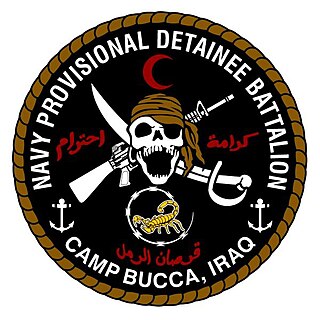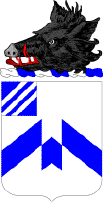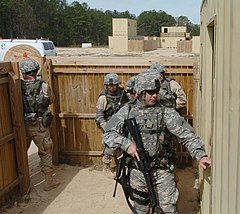
The United States Army Special Forces (SF), colloquially known as the "Green Berets" due to their distinctive service headgear, are a special operations force of the United States Army.

The United States Naval Special Warfare Command (USNSWC), also known as NAVSPECWARCOM and WARCOM, is the naval component of United States Special Operations Command, the unified command that oversees and conducts the nation's special operations and missions.
An Overseas Service Ribbon is a service military award of the United States military which recognizes those service members who have performed military tours outside the borders of the United States of America. There are different versions of the Overseas Service Ribbons for the U.S. Army, U.S. Navy, U.S. Air Force, U.S. Space Force, and the U.S. Coast Guard. Both the U.S. Navy and the U.S. Marines receive the Navy and Marine Corps Overseas Service Ribbon.

The Parachutist Badge, also commonly referred to as "Jump Wings", is a military badge of the United States Armed Forces. Some services, such as the Marine Corps, officially refer to it as an insignia instead of a badge. The United States Space Force and United States Coast Guard are the only branches that do not award the Parachutist Badge, but their members are authorized to receive the Parachutist Badges of other services in accordance with their prescribed requirements. The DoD military services are all awarded the same Military Parachutist Badge. The U.S. Army and U.S. Air Force issue the same Senior and Master Parachutist Badges while the U.S. Navy and U.S. Marine Corps issue the Navy and Marine Corps Parachutist Insignia to advanced parachutists. The majority of the services earn their Military Parachutist Badge through the U.S. Army Airborne School.

A combat medic is responsible for providing emergency medical treatment at a point of wounding in a combat or training environment, as well as primary care and health protection and evacuation from a point of injury or illness. Additionally, medics may also be responsible for the creation, oversight, and execution of long-term patient care plans in consultation with or in the absence of a readily available doctor or advanced practice provider. Combat medics may be used in hospitals and clinics, where they have the opportunity to work in additional roles, such as operating medical and laboratory equipment and performing and assisting with procedures.
A Military Transition Team or Transition Team, commonly abbreviated as MiTT, in the context of the United States Military, is a 10 – 15 soldier team that trains foreign national and local security forces. The term has been used in the "War on Terror" to designate groups training the Iraqi Security Forces in particular. By comparison, Afghan Army and other Afghan security forces are mentored and trained by US Embedded Training Teams (ETTs) and the Operational Mentoring and Liaison Teams (OMLTs) of other nations.

The 1st Battalion, 227th Aviation Regiment is an attack helicopter battalion of the Combat Aviation Brigade, 1st Cavalry Division. The battalion is an AH-64 Apache battalion based at Fort Cavazos, Texas.

2nd Battalion, 23rd Marines (2/23) is a reserve infantry battalion in the United States Marine Corps located throughout the Western United States consisting of approximately 1000 Marines and Sailors. They fall under the command of the 23rd Marine Regiment and the 4th Marine Division.

A religious affairs specialist, previously known as chaplain assistant, is a member of the U.S. Army Chaplain Corps. This soldier provides expertise in religious support and religious support operations. The Religious Affairs Specialists, which is military occupational specialty (MOS) 56M, support the unit Chaplain and Commander in responding to the needs of soldiers, family members, and other authorized personnel. They provide security to Army chaplains. Duties include preparing spaces for worship, managing supplies, and ensuring the security and safety of the chaplain during combat situations.
A direct commission officer (DCO) is a United States uniformed officer who has received an appointed commission without the typical prerequisites for achieving a commission, such as attending a four-year service academy, a four-year or two-year college ROTC program, or one of the officer candidate school or officer training school programs, the latter OCS/OTS programs typically slightly over three months in length.

Religious Program Specialist (RP) is a designated rating within the United States Navy. As an essential member of Professional Naval Chaplaincy, RPs fulfill a crucial function in administering religious ministry within the Department of the Navy (DON). Together with chaplains, they form the Religious Ministry Team (RMT). In this capacity, RPs actively support the provision and facilitation of Religious Ministry, offering assistance and care to Navy and Marine Corps personnel, as well as their families, irrespective of their backgrounds and faith affiliations. Despite working in a religiously diverse environment, RPs are not mandated to hold religious beliefs nor perform pastoral counseling for the service members under their care. Due to the mobile nature of the units they may be assigned to, RPs can be stationed on Navy ships, at various Navy and Marine Corps commands, navy construction battalions, and other unique combatant units-rendering them globally deployable.

Navy Provisional Detainee Battalion 2 (NPDB2) is a United States Navy task force of 422 active duty and Naval Reserve Sailors formed 1 May 2006 for the purpose of combat duties in Iraq.

The 30th Infantry Regiment is a United States Army infantry regiment. It was originally constituted 2 February 1901 in the Regular Army as the 30th Infantry. It was organized 12 February – 19 August 1901 at Fort Logan, Colorado, at the Presidio of San Francisco, California, and in the Philippines.

The Wyoming Air National Guard (WY ANG) is the aerial militia of the State of Wyoming, United States of America. It is, along with the Wyoming Army National Guard, an element of the Wyoming National Guard.
The 32nd Infantry Regiment is a battalion within the United States Army. Of the original regiment, only the 1st Battalion remains as an active duty unit. The 1st Battalion, 32nd Infantry Regiment is a light infantry battalion assigned to the 1st Brigade Combat Team, 10th Mountain Division, garrisoned at Fort Drum, New York. The battalion was previously assigned to the 3rd Brigade Combat Team at Fort Drum, before this unit was reflagged to Fort Johnson, formerly Fort Polk, Louisiana.

The 52nd Infantry Regiment is an infantry regiment of the United States Army.

The 42nd Military Police Brigade is a military police brigade of the United States Army based at Joint Base Lewis-McChord in Washington. It is a subordinate unit of I Corps.
68W is the Military Occupational Specialty (MOS) for the United States Army's Combat Medic. 68Ws are primarily responsible for providing emergency medical treatment at point of wounding on the battlefield, limited primary care, and health protection and evacuation from a point of injury or illness. 68Ws are certified as Emergency Medical Technicians (EMT) through the National Registry of Emergency Medical Technicians (NREMT). However, 68Ws often have a scope of practice much wider than that of civilian EMTs. This specialty is open to males and females with minimum line scores of 107 GT and 101 ST on the Armed Services Vocational Aptitude Battery (ASVAB).

A United States Air Force Tactical Air Control Party, commonly abbreviated TACP, is an individual or team of United States Air Force Special Warfare Airmen with AFSC 1Z3X1, who are aligned with conventional, Special Operation Forces, and Tier 1 combat maneuver units. They provide precision terminal attack control and terminal attack guidance of U.S. and coalition fixed- and rotary-wing close air support aircraft, artillery, and naval gunfire; establish and maintain command and control (C2) communications; and advise ground commanders on the best use of air power.

The Master-at-Arms (MA) rating is responsible for law enforcement and force protection in the United States Navy—equivalent to the United States Army Military Police, the United States Marine Corps Military Police, the United States Air Force Security Forces, and the United States Coast Guard's Maritime Law Enforcement Specialist. It is one of the oldest ratings in the United States Navy, having been recognized since the inception of the U.S. Navy.


















